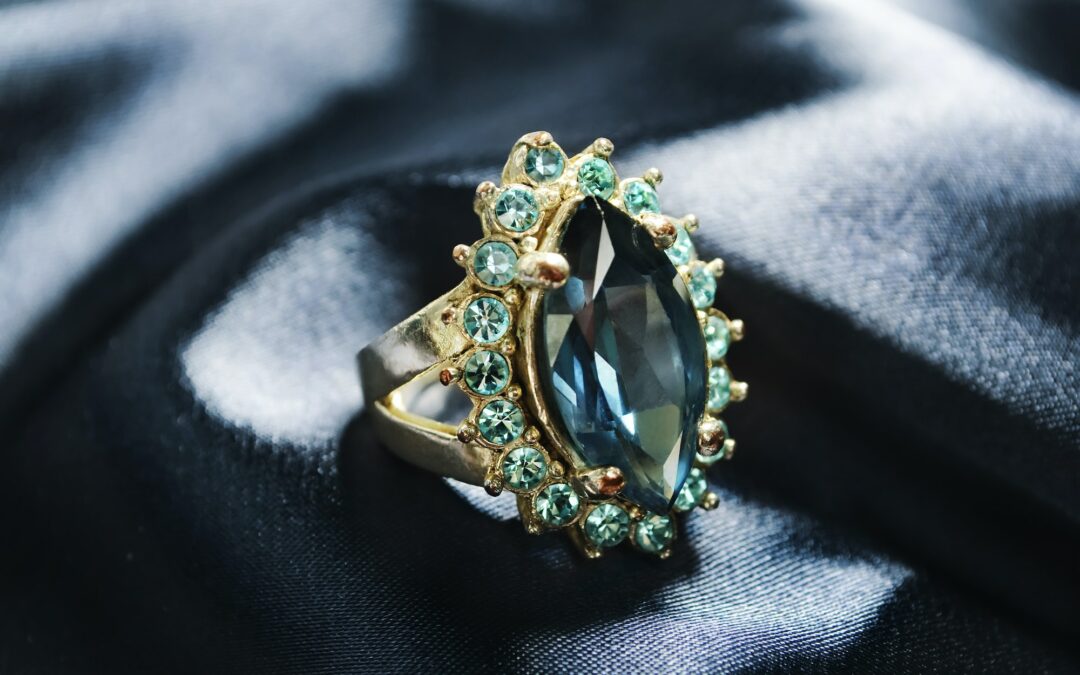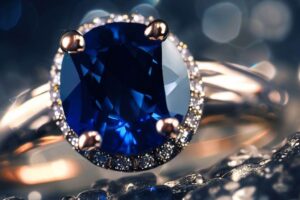Article Contents
- 1 The History of Sapphires: From Ancient Times to Modern Day
- 2 The Geology of Sapphires: How They Are Formed and Where They Are Found
- 3 The Different Colors of Sapphires: Beyond Blue
- 4 The Rarity of Sapphires: Why They Are Valuable
- 5 The Most Famous Sapphires in the World: From Royalty to Celebrities
- 6 The Symbolism of Sapphires: Love, Wisdom, and Protection
- 7 The Spiritual Properties of Sapphires: Healing and Meditation
- 8 About Sapphires in Jewellery: Rings, Necklaces, and Earrings
- 9 The Care and Maintenance of Sapphires: Cleaning and Storage Tips
- 10 About Sapphires: FAQs
- 10.1 What is the history of sapphires?
- 10.2 How are sapphires formed?
- 10.3 Are sapphires only blue?
- 10.4 Why are sapphires so valuable?
- 10.5 What are some famous sapphires?
- 10.6 What do sapphires symbolize?
- 10.7 Do sapphires have any spiritual properties?
- 10.8 What types of jewellery can sapphires be used in?
- 10.9 How should I care for my sapphire jewellery?
- 11 The Timeless Allure of Sapphires
The History of Sapphires: From Ancient Times to Modern Day
If you want to know all about sapphires, you have come to the right place!
Sapphires have been valued for their beauty and rarity for thousands of years. In ancient times, they were believed to have mystical powers and were often included in amulets and talismans. The Greeks and Romans also prized sapphires, with the latter believing that the gemstone would protect them from harm and envy.
During the Middle Ages, sapphires were associated with the heavens and symbolized holiness and purity. They were often used in religious art and jewellery. In the Renaissance period, sapphires became popular with royalty and were used in crown jewels and other regal pieces.
In the modern era, sapphires continue to be highly sought after. They have been used in engagement rings since the Victorian era, with blue sapphires becoming an increasingly popular alternative to diamonds. Today, sapphires are still used in high-end jewellery and are often associated with luxury and sophistication.
Read on to discover more fun facts about sapphires.
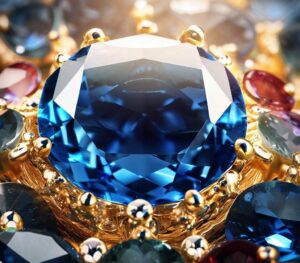
A Large Blue Sapphire Surrounded By Smaller Gemstones
The Geology of Sapphires: How They Are Formed and Where They Are Found
Sapphires are formed deep within the Earth’s crust under extreme heat and pressure. They are a type of mineral called corundum that can only be formed in specific geological conditions. Sapphires can be found in many different types of rock formations, including igneous, metamorphic, and sedimentary rocks. The most common source of sapphires is in alluvial deposits, where they have been eroded from their original location and deposited in riverbeds and other areas.
The formation of sapphires can take millions of years, and the conditions required for their formation are quite rare. Sapphires are typically formed in areas where there is high pressure and heat, such as near volcanic activity or deep within the Earth’s crust. The process of formation involves the gradual crystallization of corundum minerals, which eventually develop into sapphires. The color of sapphires is determined by the presence of trace elements such as iron, titanium, and chromium, which can create a range of colors from blue to pink, yellow, and orange.
Sapphires are found in many different parts of the world, including Sri Lanka, Thailand, Australia, Madagascar, and the United States. Some of the most famous sapphire deposits are located in Kashmir, where the finest quality sapphires are found. Other notable sources of sapphires include Cambodia, Myanmar, and Tanzania. The location and conditions of the deposits can have a significant impact on the quality and value of the sapphires that are found.
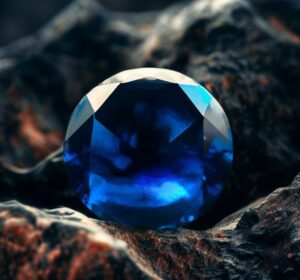
Sapphires Are Formed Deep Below The Earth – They Don’T Look Like This When Dug Up!
The Different Colors of Sapphires: Beyond Blue
Sapphires are commonly known for their blue colour, but they can come in a wide range of hues. One of the most popular colours after blue is pink sapphire. This feminine and delicate colour is often used in engagement rings and is believed to represent love, passion, and fidelity. Pink sapphires are found in Madagascar, Sri Lanka, and Myanmar, among other places.
Yellow sapphires are another popular colour. They are believed to symbolize wisdom, wealth, and good fortune. Yellow sapphires can range from light lemon to deep golden hues. They are found in Sri Lanka, Madagascar, and Tanzania, among other places. Yellow sapphires are often used in jewellery that is meant to bring prosperity and abundance.
Green sapphires are rare and highly valued. They are believed to represent growth, renewal, and balance. Green sapphires can range from light mint to deep forest green hues. They are found in Madagascar, Australia, and Tanzania, among other places. Green sapphires are often used in nature-inspired jewellery and are highly sought after by collectors.
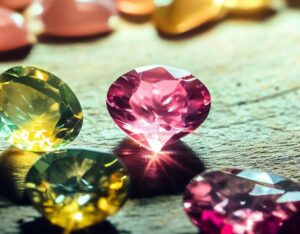
Pink, Yellow, And Green Sapphires On A Jeweller’S Workbench.
The Rarity of Sapphires: Why They Are Valuable
Sapphires are one of the rarest gemstones in the world, and this is one of the reasons why they are so valuable. Unlike diamonds, which are found in many countries, sapphires are only found in certain parts of the world. The most famous sapphire mines are located in Kashmir, Myanmar, and Sri Lanka, and these mines have produced some of the most valuable sapphires in history.
Another reason why sapphires are so rare is that they are formed under very specific geological conditions. Sapphires are a type of corundum mineral, which means they are formed in metamorphic rocks that have been subjected to high temperatures and pressures. This process takes millions of years and only occurs in certain parts of the world. As a result, sapphires are a limited resource that is becoming increasingly rare.
The rarity of sapphires is also due to their unique colour variations. While blue sapphires are the most famous, sapphires can also be found in pink, yellow, green, and even colourless varieties. However, each colour variation is extremely rare and difficult to find, which is why sapphires in these colours are highly prized by collectors and investors alike. Overall, the rarity of sapphires is what makes them such a valuable and coveted gemstone.
The Most Famous Sapphires in the World: From Royalty to Celebrities
One of the most famous sapphires in the world is the Star of India, a 563-carat sapphire that is currently on display at the American Museum of Natural History in New York. This blue-grey sapphire was discovered in Sri Lanka over 300 years ago and has a long and intriguing history. It was stolen from the museum in 1964 but was recovered a few days later in a locker at a Miami bus station.
Another famous sapphire is the Stuart Sapphire, which is set in the British Imperial State Crown. This sapphire is over 300 years old and was worn by King James II at his coronation in 1685. The Stuart Sapphire is considered to be one of the most important jewels in the British Crown Jewels collection and is believed to bring good luck and protection to the wearer.
The late Princess Diana also owned a famous sapphire engagement ring, which is now worn by her daughter-in-law, Kate Middleton. This 12-carat oval blue sapphire is surrounded by 14 diamonds and is set in 18-karat white gold. The ring was originally purchased by Prince Charles and was described by the princess as her “most favourite” piece of jewellery. Its popularity has sparked a trend in sapphire engagement rings, making it a modern-day classic.
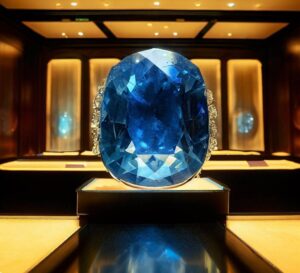
A Very Large Sapphire In Its Display Case In A Museum
The Symbolism of Sapphires: Love, Wisdom, and Protection
There are many long-held beliefs about sapphires, going back for many centuries and in many parts of the world. Sapphires have long been associated with love, wisdom, and protection. In ancient times, sapphires were believed to protect the wearer from harm and illness. They were also used as gifts to symbolize love and commitment. In the Middle Ages, sapphires were considered a symbol of wisdom and were often worn by scholars and intellectuals.
In addition to their protective and symbolic qualities, sapphires are also believed to have healing properties. They are said to promote mental clarity, improve communication, and enhance intuition. Some people also use sapphires in meditation to help calm the mind and promote inner peace.
Today, sapphires continue to be a popular choice for engagement rings and other types of jewellery. They are prized not only for their beauty and rarity but also for their deep symbolic meaning. Whether given as a gift or worn for personal reasons, sapphires are a timeless and meaningful choice for any occasion.
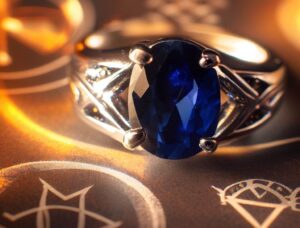
Sapphires, Symbols Of Love, Wisdom And Protection
The Spiritual Properties of Sapphires: Healing and Meditation
Sapphires have been associated with spiritual healing and meditation for centuries. In ancient times, people believed that sapphires had the power to ward off evil spirits and protect the wearer from harm. It was also believed that sapphires could improve mental clarity and help the wearer achieve a state of inner peace and tranquillity. Today, many people still believe in the spiritual properties of sapphires and use them for healing and meditation purposes.
In alternative healing practices, sapphires are believed to have a calming effect on the mind and body. They are said to help reduce stress and anxiety and promote mental clarity and focus. Some people also believe that sapphires can help stimulate the third eye chakra, which is associated with intuition, wisdom, and spiritual consciousness. Sapphires are also believed to help balance the throat chakra, which is associated with communication and self-expression.
When used for meditation, sapphires are believed to help the wearer achieve a deeper state of meditation and connect with their inner self. They are said to help facilitate spiritual growth and enhance one’s spiritual awareness. Some people also believe that sapphires can help stimulate the kundalini energy, which is believed to be a powerful source of spiritual energy that lies dormant at the base of the spine. Overall, sapphires are a popular choice for those who are looking to enhance their spiritual practice and achieve a greater sense of inner peace and harmony.

Sapphires, Symbols Of Spirituality And Meditation
About Sapphires in Jewellery: Rings, Necklaces, and Earrings
Sapphires have been used in jewellery for centuries, and they are still a popular choice today. One of the most common ways to use sapphires in jewellery is in rings. Sapphires can be used as the centre stone in an engagement ring or as accent stones on the band. They can also be used in cocktail rings for a statement piece. Sapphires come in a range of colours, so there is a perfect shade for everyone’s taste.
Necklaces are another popular way to use sapphires in jewellery. A simple pendant with a single sapphire can add a touch of elegance to any outfit. Sapphires can also be used in more elaborate necklaces with multiple stones or in combination with other gemstones. One popular style is a sapphire and diamond necklace, where the two stones complement each other perfectly.
Earrings are a versatile way to use sapphires in jewellery. They can be worn every day or for special occasions. Stud earrings with a single sapphire are a classic look, while drop earrings with multiple stones can add drama and sophistication. Sapphires can also be used in hoop earrings or as part of a chandelier design. Whatever the style, sapphire earrings are sure to impress.
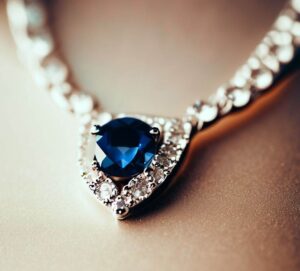
A Classic Sapphire And Diamond Necklace, The Stones Complement Each Other Perfectly
The Care and Maintenance of Sapphires: Cleaning and Storage Tips
Cleaning and storing your sapphires properly is essential to maintain their beauty and value. To clean your sapphire jewellery, use a soft-bristled brush and warm soapy water. Avoid using harsh chemicals or ultrasonic cleaners as they can damage the gemstone. After cleaning, dry the jewellery thoroughly with a soft cloth.
When storing your sapphires, keep them in a safe and dry place, away from direct sunlight. Wrap each piece of jewellery in a soft cloth or tissue paper to prevent scratches and damage from rubbing against other jewellery. You can also store your sapphires in a jewellery box with compartments or a soft-lined case.
To ensure the longevity of your sapphire jewellery, have it inspected and cleaned by a professional jeweller at least once a year. They can check for any loose stones or potential damage and make any necessary repairs. By following these simple care and maintenance tips, your sapphires will continue to sparkle for many years to come.
About Sapphires: FAQs
What is the history of sapphires?
Sapphires have been prized for their beauty and rarity since ancient times. They were believed to have protective powers and were often worn by royalty and nobility.
How are sapphires formed?
Sapphires are formed deep within the earth’s crust under high pressure and temperature. They are typically found in igneous and metamorphic rocks.
Are sapphires only blue?
No, sapphires come in a variety of colours, including pink, yellow, green, and even colourless. The most valuable sapphires are typically blue, but other colours can be just as beautiful.
Why are sapphires so valuable?
Sapphires are rare and highly prized for their beauty and durability. The most valuable sapphires are typically those that are a deep, rich blue colour.
What are some famous sapphires?
Some of the most famous sapphires include the Star of India, the Logan Sapphire, and Princess Diana’s engagement ring.
What do sapphires symbolize?
Sapphires are often associated with love, wisdom, and protection. They are believed to bring peace and tranquillity to the wearer.
Do sapphires have any spiritual properties?
Yes, sapphires are believed to have healing and meditative properties. They are said to promote mental clarity and spiritual growth.
What types of jewellery can sapphires be used in?
Sapphires can be used in a variety of jewellery, including rings, necklaces, earrings, and bracelets.
How should I care for my sapphire jewellery?
To care for your sapphire jewellery, clean it regularly with a soft cloth and mild soap and water. Store it in a cool, dry place away from other jewellery to prevent scratches.
The Timeless Allure of Sapphires
Thanks for reading this article about sapphires; we hope that you have found it interesting and useful!
Sapphires have captivated the hearts and imaginations of people throughout history due to their remarkable beauty, rarity, and rich symbolism. With their diverse range of colours and uses in various types of jewellery, sapphires continue to be a popular choice for those seeking a precious gemstone with deep meaning and timeless elegance.
Whether it’s a symbol of love, wisdom, or protection, a sapphire’s allure transcends time and culture. By understanding their formation, significance, and proper care, you can truly appreciate the magnificence of these extraordinary gemstones and ensure that your sapphire jewellery remains a cherished treasure for generations to come.
Please take a moment to browse the collections of diamond and sapphire jewellery offered by All Diamond, a UK specialist in British-designed and handcrafted fine jewellery. We think that their collections will inspire you!

